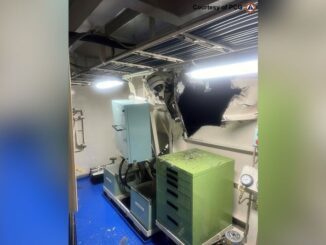
The Philippines and China have reached an understanding on an arrangement that will avoid altercations at a disputed South China Sea Shoal, the Department of Foreign Affairs said Sunday.
The move is aimed at easing tensions after last month’s violent confrontation at the Philippine-occupied Ayungin Shoal being claimed by Beijing.
Both sides have laid out a set of mutually agreed principles and arrangement at the shoal, also known by its international name Second Thomas Shoal and called Ren’ai Jiao by the Chinese, through an exchange of diplomatic notes this week, diplomatic sources told GMA News Online.
“The Philippines and the People’s Republic of China have reached an understanding on the provisional arrangement for the resupply of daily necessities and rotation (RoRe) missions to the BRP Sierra Madre in Ayungin Shoal,” the DFA said in a statement.
The two Asian neighbors, locked in years-long overlapping claims over South China Sea territories, have agreed to finalize the document following a series of negotiations.
It was an offshoot of a crucial high-level meeting in Manila on July 2, called the Bilateral Consultation Mechanism (BCM), held two weeks after hostilities broke between the Chinese Coast Guard and the Philippine Navy, who were blocked, harassed, and attacked by Chinese personnel while bringing food and other supplies to Ayungin in June 17. Several Filipino troops were injured, including one sailor who lost his right thumb.
Analysts feared that the incident – the most violent to date – may result to more dangerous unplanned encounters that may escalate to a full-blown conflict.
“This was achieved after a series of consultations following the frank and constructive discussions between the two sides during the 9th Bilateral Consultation Mechanism (BCM) on the South China Sea in Manila on 2 July 2024,” the DFA said.
At the July 2 meeting, Philippine Foreign Affairs Undersecretary Ma. Theresa Lazaro and Chinese Vice Foreign Minister Chen Xiaodong agreed to find a “mutually-acceptable resolution to the issues” despite “significant differences” in their respective countries’ positions.
China has insisted that former and present Philippine government officials, including then President Rodrigo Duterte, agreed in private to only transport food and necessary supplies to Sierra Madre and that it will notify China of its resupply operations – a claim rejected by the Marcos administration. Philippine officials said they will never agree to such demands by China.
Such conditions by China were not included in the signed document, diplomatic sources told GMA News Online.
A rusting World War II-era vessel, the BRP Sierra Madre, has been intentionally grounded by the Philippines at the shoal in 1998 in response to China’s occupation of Philippine-claimed Mischief Reef in 1995.
Manned by a small Filipino navy contingent, Sierra Madre serves as a military outpost and a symbol of Philippine sovereignty.
China’s repeated attempts to block Philippine resupply missions and rotational troop deployment to the shoal by firing high-pressure water cannons, intentional ramming and other dangerous maneuvers have raised tensions, prompting condemnations and concern from several regional and global powers, led by the United States. China defended its actions against the Philippines, accusing it of bringing construction materials to fortify the ship.
Washington has warned that it has a treaty obligation to defend the Philippines from hostile armed attacks.
“Both sides continue to recognize the need to de-escalate the situation in the South China Sea and manage differences through dialogue and consultation and agree that the agreement will not prejudice each other’s positions in the South China Sea,” the DFA said.
Ayungin is 105.77 nautical miles from the nearest Philippine province of Palawan and constitutes part of the country’s 200-nautical mile exclusive economic zone and continental shelf as provided under a United Nations convention.
On June 17, Chinese Coast Guard rammed Philippine vessels, seized firearms and rubber boats, and threatened Filipino soldiers with knives, axes and spears to prevent them from delivering food, firearms and other supplies to Filipino troops at the shoal.
Chinese personnel also slashed the Philippines’ Rigid Hull Inflatable Boats (RHIB) and smashed its navigational screens.
It triggered strong protests from Manila, with President Ferdinand Marcos Jr. calling it “deliberate and illegal.” Manila demanded China to return the Philippine vessels and firearms.
A vital trading and shipping lane, the South China Sea, dotted with rocks, shoals and reefs where rich oil and mineral deposits were found, are claimed in part or in whole by the Philippines, China, Vietnam, Malaysia, Brunei, and Taiwan. Parts of the waters that fall within Philippine territory have been renamed by the government as West Philippine Sea to reinforce the country’s claim.
The Philippines largely won a landmark case against China’s massive claim in the South China Sea. On July 16, 2016, an arbitral tribunal in The Hague, Netherlands, invalidated China’s indisputable and historical claims, but Beijing does not recognize the ruling. —RF, GMA Integrated News





Be the first to comment